Anton Port și mașina timpului
Ați cunoscut vreodată unul din acei „savanţi nebuni” care mereu meştereşte ceva în atelierul său, despre care nimeni, de fapt, nu ştie cam nimic, şi nici nu se ştie ce maşinării diabolice iau naştere acolo? Uitaţi de partea cu nebunia, adăugaţi o mulţime de energie, talent şi ambiţie, şi-l veţi obţine pe domnul Anton Port. O persoană ce întotdeauna a visat la un viitor mai bun, mai verde, şi care niciodată nu şi-a uitat rădăcinile. Pentru cei mai mulţi dintre noi, aceste aspiraţii au rămas doar în memorie, dar nu şi pentru el.
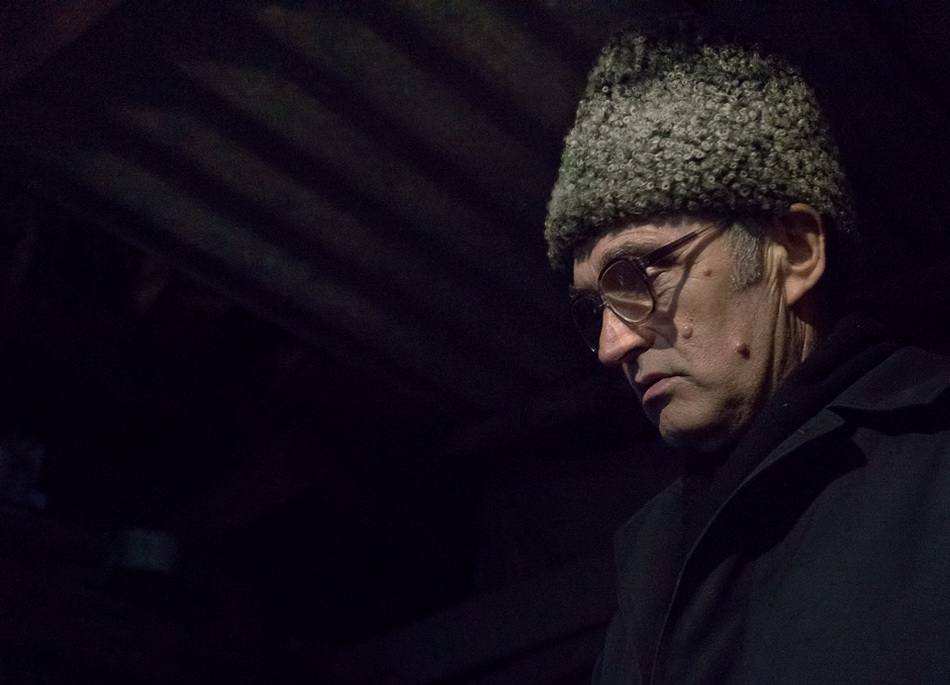
Acel moment de răscruce din viaţa sa, s-a întâmplat acum 40 de ani în urmă, atunci când eroul istoriei noastre îşi îndeplinea serviciul militar în Forţele Armate Sovietice, situate în Germania de Est (RDG). Pe lângă îndatoririle de soldat, mai făcea parte şi din ansamblul militar de dansuri, ceea ce presupunea o mulţime de călătorii. Ca rezultat, în una din aceste călătorii a întâlnit un neamţ care tăia lemne la o maşinărie conectată la o moară de vânt. Şi atunci şi-a spus: „Ce idee grozavă! Sunt sigur că şi eu aş putea construi aşa ceva.”
Acesta a şi fost primul grăunte din care a crescut tot ceea ce există acum. A fost atât de inspirat de revelaţia că în jurul nostru există un potenţial nelimitat de energie naturală, încât a decis că vrea să construiască propriile măşinării ce l-ar ajuta să recolteze aceste resurse regenerabile. În câţiva ani s-a întors din armată, a intrat la facultatea de matematică, s-a căsătorit şi a construit propria casă, împreună cu atelierul.
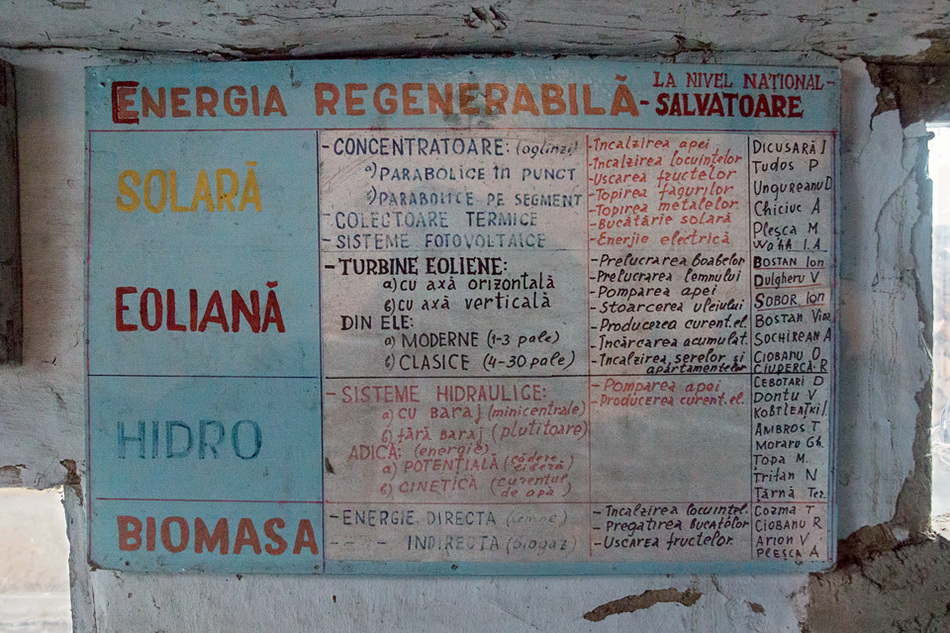
Au trecut deja trei ani de când am aflat despre el. Făceam parte dintr-un grup de voluntari, şi am vizitat cu un proiect şcoala-internat locală. În drum spre ea am observat o moară de vânt uriaşă în curtea cuiva, şi am rămas impresionat pentru că nu era ceva ce te-ai fi aşteptat să întâlneşti într-un sat moldovenesc. Când am ajuns acasă am încercat să găsesc ceva informaţie pe internet, dar am fost neplăcut surprins când n-am dat de nimic, deoarece evident îmi păru o persoană neobişnuită.
Îndată ce apăru momentul potrivit, mi-am făcut o echipă pentru a-i relata istoria, am ales o zi și eram gata de plecare. Vremea era îngrozitoare, ploua de două zile și ceața era atât de densă încât puteai să tai felii din ea. Satul său, Popeasca, este la o distanţă de aproximativ 90 kilometri de Chişinău, iar cum de obicei drumurile din zonele rurale sunt pline de noroi, am decis să luăm mașina și să folosim un navigator GPS, ca nu cumva să ne rătăcim. Acesta ne-a condus pe cel mai rău traseu posibil, deși ar trebui să recunosc că a fost şi cel mai scurt. De fapt, părea că vremea și navigato- rul lucrau împreună, şi încercau să ne aducă la dispoziţia potrivită pentru ce avea să urmeze. Sau poate astea erau acţiunile unei maşinării secrete ce controlează vremea, construite de Port?
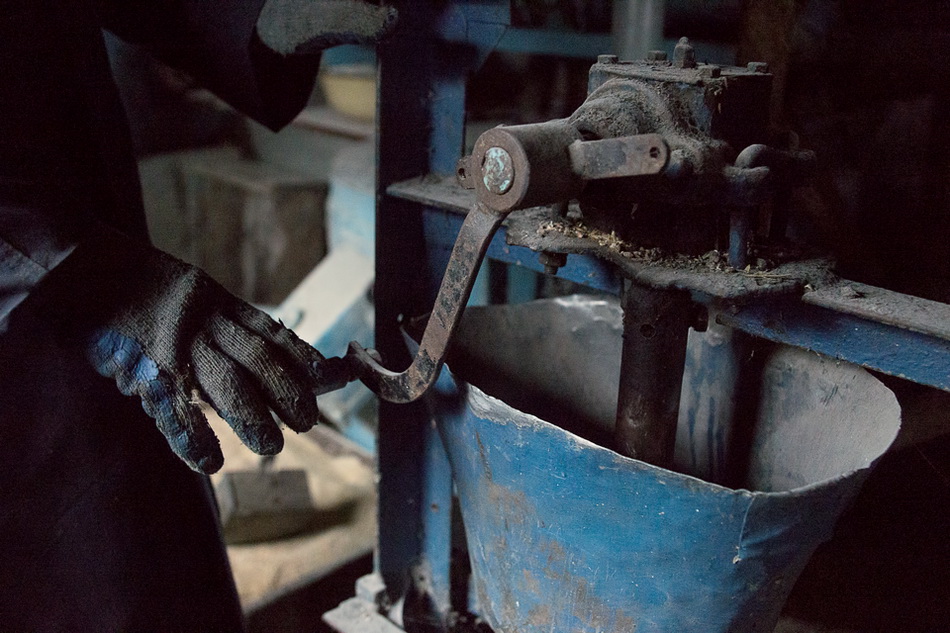
Ne-a luat de două ori mai mult timp ca să ajungem la el, decât ne-ar fi trebuit în mod normal, dar în final am reuşit. Prima care ne-a întâmpinat a fost soţia sa – o doamnă prietenoasă, care nici nu prea ne-a pus prea multe întrebări, părând că e obişnuită cu oaspeţi. După ce am primit ceva atenţie şi de la un câine mic, dar furios, şi o pisică nepăsătoare, a apărut şi Anton. Purta un palton de culoare închisă, o pereche de ochelari mari şi o căciulă ciobănească. Abordarea lui era ceva mai neutră, poate chiar un pic sceptică. Îţi dădeai seama după întrebările care ne le punea, de parcă ne testa dacă suntem impostori sau chiar spioni: „Ce ştiţi despre mine? Cine credeţi că sunt eu?”. După ce am răspuns aparent corect, am intrat într-o cameră mică, care e folosită pentru lecţii de sculptură în lemn şi lut. Copiii se isprăvesc destul de bine, spune Anton, dar se plictisesc repede, şi de aceea e greu să-i convingi să-şi dezvolte abilităţile, chiar şi pe cei mai talentaţi. De asemenea, îi învaţă şi alte meşteşuguri tradiţionale, cum ar fi confecţionarea măturilor şi coşurilor. Uneori, reutilizează fire de metal şi benzi din plastic vechi pentru a face aceste coşuri, astfel învăţând copiii despre importanţa reciclării, chiar şi la un nivel atât de mic.
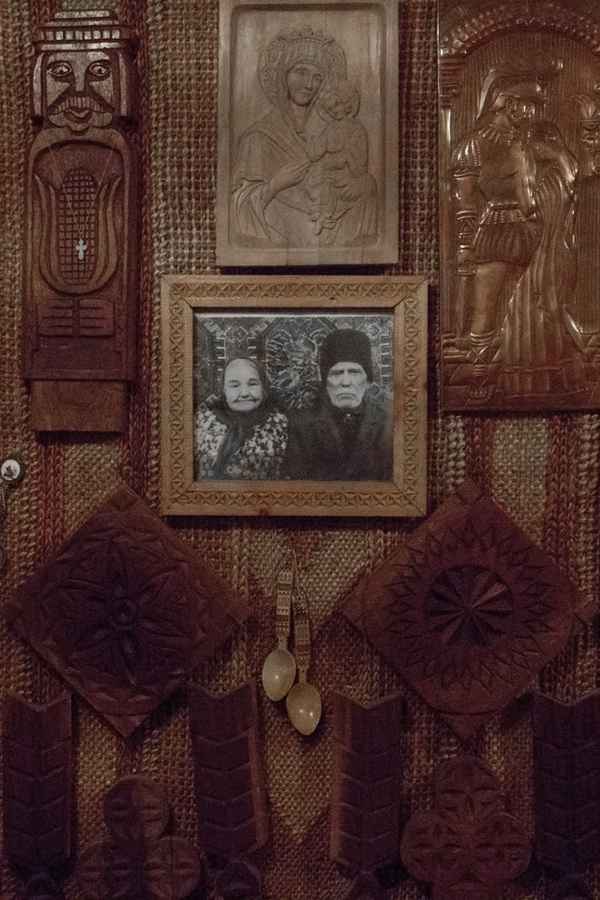
A portrait of Anton’s ancestors situated in his home museum “Casa Mare”.
A venit timpul să vizităm atelierul propriu-zis, cu denumirea oficială de „Centrul de Valorificare a Energiei Netradiţionale Pur Ecologice”. Oamenii de ştiinţă adoră denumiri lungi şi încurcate, nu-i aşa? Aici puteţi găsi tot felul de instrumente folosite pentru confecţionarea şi repararea invenţiilor sale, dar şi o presă de ulei, un dispozitiv vibrator folosit pentru separarea seminţelor de gunoi, o moară de grâu cu pietre special aduse din Olanda, ce produce până la 40 kg de făină pe oră, şi un generator ce poate produce cinci kilowaţi-oră, suficient pentru a alimenta trei becuri. Toate astea pot fi conectate la moara de vânt, iar productivitatea lor depinde de puterea vântului.
În spatele atelierul se înalţă încă o moară de vânt, asemănătoare cu cea ce l-a inspirat în tinereţe pe Anton. Pe lângă faptul că alimentează maşina de tăiat lemne, mai pot fi conectate maşina de ascuţit, bormaşina şi sistemul de irigare, inventat tot de el. Acest sistem este compus dintr-un rezervor subteran de 30 de tone, în care se colectează apa de ploaie, şi o pompă (la fel alimentată de moară) ce împinge apa într-o cisternă încălzită de soare. Ulterior, lichidul este distribuit printr-un sistem de irigare prin picurare, astfel plantele primindu-şi doza zilnică de apă.
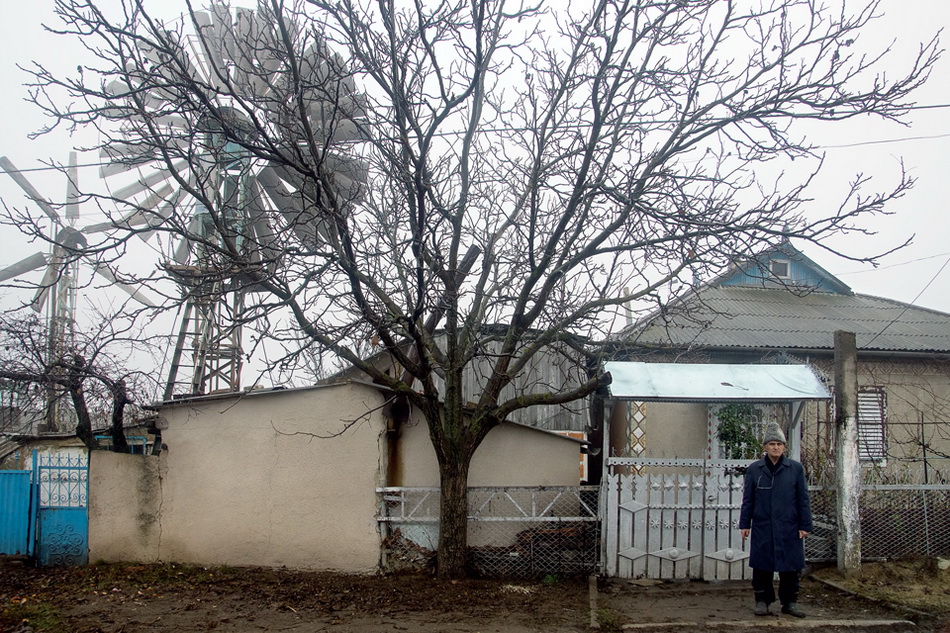
Cel mai mult m-a intrigat oglinda parabolică solară. Pare a fi o antenă satelit, dar nu o veţi putea conec- ta la un televizor. Suprafaţa interioară este acoperită cu aproximativ 800 de bucăţi de oglindă, ce concentrează razele solare într-un singur punct, care poate atinge o temperatură de până la 1500°C, ceea ce e mai mult decât suficient pentru a găti. Iar dacă veţi sta cu faţa spre cen- trul antenei şi veţi încercă să spuneţi ceva, veţi avea partea de un efect acustic total deosebit. Al doilea cuptor solar este special conceput pentru a putea coace pâine, plăcinte, legume sau chiar carne. Mai există şi un captator de căldură solară, care vara încălzeşte apa, iar iarna e fo- losit ca uscător de fructe.
O mulţime de alte utilaje sunt împrăştiate prin curtea şi atelierul său, fiecare din ele având scopuri diferite, dar totuşi au un lucru în comun: au fost construite din fier vechi şi deşeuri, şi majoritatea din ele au fost concepute, proiectate şi asamblate de el singur, ceea ce zic eu, e destul de impresionant.
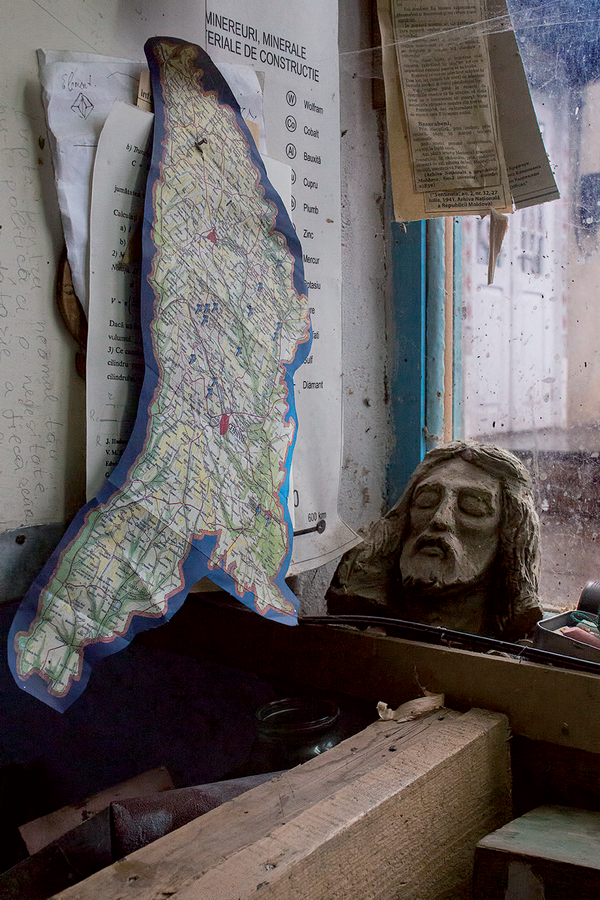
One of the religious symbols often present in his works situated in the carving class at his home.
Mai mult de atât, cred că v-ar fi interesant să aflaţi că dumnealui ştie să cânte la șapte instrumente diferite, inclusiv fluiere din lemn şi tuburi (în mare parte confecţionate tot de el), ocarină, chitară, şi chiar şi la frunză. Toate astea fac parte din muzeul său, numit Casa Mare, ce este amplasat în una din camerele locuinţei sale.
Pe când maşinăriile sale îi reprezintă mâinile iscusite şi mintea strălucită, muzeul pare a fi oglinda sufletului şi inimii lui. Ai nevoie de doar câteva clipe pentru a simţi atmosfera arhaică ce te înconjoară ca o ceaţă densă şi misterioasă. Era ceva asemănător cu vremea de afară, dar la un nivel spiritual. Camera era plină de sculpturi din lemn şi lut, care într-un mod sau altul erau dedicate suferinţei, iar după ce am privit mai atent în jurul meu, am înţeles că acest muzeu reprezintă viaţa lui. Aici mai puteţi găsi albume cu fotografii, covoare şi feţe de pernă tradiţionale, o mulţime de diplome şi premii, proiectele invenţiilor sale, şi multe alte lucruri. Erau atât de multe concentrate într-o cameră mică, iar simbolismul se simțea atât de tare, încât sunt sigur că oricine ar fi putut fi înghiţit de atmosferă, chiar dacă n-ar avea nici o tangenţă cu această cultură.
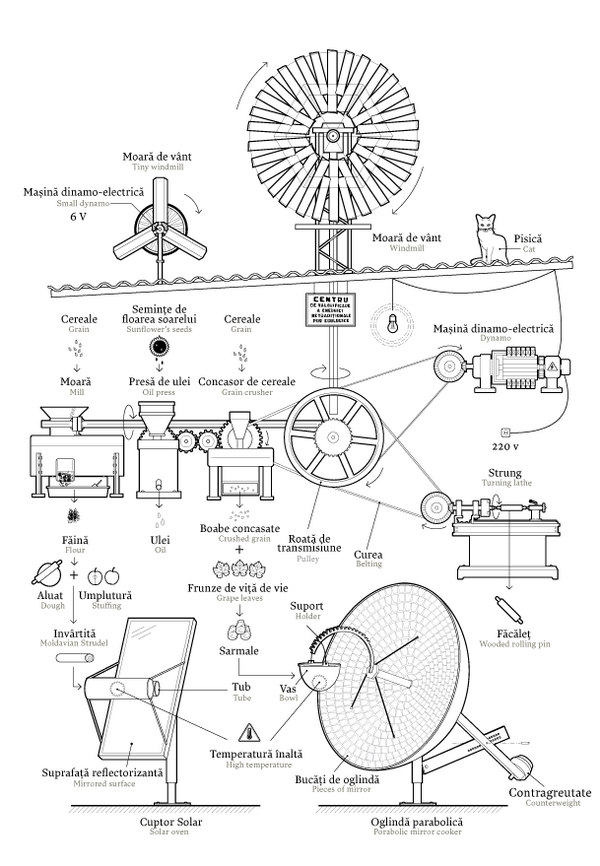
A blueprint interconnecting his different inventions into a single self sustainable system.
În ciuda neliniştii interioare, totuşi cred că dl. Anton este un om fericit și împlinit. Având o soție minunată și înţelegătoare, o gospodărie frumoasă și atât de inteligentă, doi copii și nepoţi, ar fi păcat dacă n-ar fi aşa. Fiind inspirat de basme moldoveneşti şi româneşti, a construit un loc de joacă și „Coliba cu Poveşti”, special pentru ei. Doar mai târziu am atras atenţie la colecţia de ceasuri din colibă (am numărat 8), ceea ce mi-a părut neobişnuit. Încearcă el oare să oprească timpul pentru copii? Sau din contra, vrea să le reamintească că timpul se scurge?
Deci, am ajuns la finalul vizitei, dar înainte de a pleca am fost serviţi nişte vin şi struguri de casă, şi ştiţi voi – tradiţia spune că nu prea poţi pleca pănă nu guşti din ele, pentru că ar fi un pic jignitor pentru stăpânii ca sei. În timp ce ne conducea înspre poartă, Anton a observat cât timp deja trecuse şi expresia feţei sale a revenit la cea pe care o purta la început – de om îngândurat. Deja întârzia cu ajutorul promis unui prieten, aşa că am dat mâna, i-am mulţumit pentru tot, am urcat în maşină şi am plecat. Chiar dacă am petrecut acolo doar două ore, în realitate a părut ca o eternitate. Am avut atât de multe de văzut, auzit şi simţit, încât ar fi părut imposibil să reuşim fără o călătorie în timp.
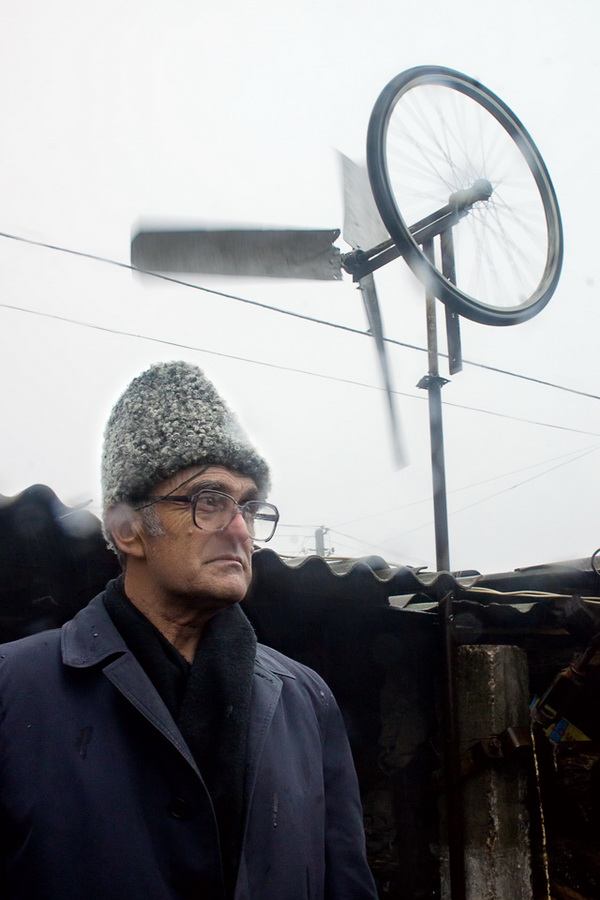
Anton Port poses near a small windmill, which is a project of one of his students.
Şi doar încă ceva mai am de spus. Cred că totuşi am greşit atunci când am spus să uitaţi de partea cu nebunia. Dacă toţi ar şti câtă nebunie are el în sine, ar fi şi mai invidioşi. Şi n-ar fi el omul ce a ajuns să fie, de n-ar mai avea încă un talent deosebit: de a şti să-şi controleze nebunia şi de a o pune la muncă, la fel cum a făcut cu soarele, apa şi vântul.
Text: DAN POSTOLACHI
Photos: MARINA ZABUGHINA
Illustration: IGOR UDUSLIVII
© articolul din revista „NOUA”, creată în cadrul atelierului “Publish Yourself!”
Revista va putea fi cumpărată la Yard Sale cu o donaţie de 100 lei.
Anton’s Time Machine
Have you ever heard of those “mad scientists” who are always tinkering with something in their workshop, and nobody actually knows what sort of devilish machinery they are creating? Take out the “mad” part, add tons of energy, talent, and ambition, and you’ll get Anton Port. A man who has always dreamed of a better, greener future, but never forgot his roots. Most of us just keep these dreams to ourselves, hoping that some day we might return to them, but that’s not his story.

The main turning point in his life happened back in the 1970s, when he was serving in the Soviet Armed Forces in East Germany. As well as being a soldier, he was also a dancer in the army’s dance ensemble, which meant a lot of travelling. On one of those trips he saw a lumberjack using a wind-powered sawmill to cut and chop wood. That’s when Anton told himself: “That’s a great idea! I’m sure I can do that too.”
So there you have it – the seed was planted. Inspired by the revelation that there is unlimited natural energy all around us, he decided to build his own gizmos for harvesting renewable energy. When he got back from the army a couple of years lat- er, he joined the mathematics faculty, got married, and built his own house, with the workshop next to it.

The first time I found out about him was three years ago. I was working as part of a group of volun- teers, and we had a project at a local orphanage. While driving to it, I noticed a big metal windmill in somebody’s yard and thought: “Wow! That’s something you don’t expect to see in a Moldovan village.” When I got back home I tried googling it and was surprised when nothing came up, because obviously whoever was behind this was no ordinary person. So I got a team together for the sto- ry, we picked a day, and were ready to go.
The weather was awful. It was raining for two days and the fog was so dense you could cut it with a but- ter knife. The small village Popeasca is around 90 kilometres away from Chişinău, and usually you don’t get nice roads in rural areas, so we decided to take a car and use a GPS navigator, in case we might get lost. It took us on the worst possible route, although I have to admit it was the shortest one. Actually, it looked like the weather and the navigator knew what they were doing, trying to get us in the proper mood for what was about to follow. Or maybe Anton had built some sort of weather control device he kept secret.

It took us twice as much time as we should have needed to get there, but we still found his house. The first to greet us was his wife – a friendly lady, who didn’t even ask us many questions, as she seemed used to visitors. After a furious little dog and a nonchalant cat gave us some attention, Anton came out. He was wearing a long dark jacket, big glasses, and a traditional shepherd’s headpiece. His approach was more neutral, maybe even a bit sceptical. You could tell by the questions he was asking us, which suggested he was trying to figure out if we were impostors, or even spies. “What do you know about me? Who do you think I am?” After we gave what we thought would be the right answers, he took us to a small room, next to his barn, which he used for clay sculpting and children’s wood carving classes. The kids are doing pretty great, said Anton, but they get bored fast, and it’s hard to persuade even the talented ones to develop their skills. He also teaches them other traditional crafts like broom making and basket weaving. Sometimes they reuse old wires and plastic strips to make those baskets, explaining the kids the importance of recycling, even at a low level.

A portrait of Anton’s ancestors situated in his home museum “Casa Mare”.
It was time to go in the barn, which is actually called “The Centre for Harnessing Purely Ecological Untraditional Energy.” Scientists just love long and tricky names, don’t they? Here we found tools for crafting or repairing inventions, and machines like an oil press, a special vibrating device for sorting out seeds from garbage, a grain mill plus millstones he got from the Netherlands, which allow him to grind up to 40 kilos of flour per hour, and a generator that produces a maximum of five kilowatt hours, enough to pow- er three light bulbs. All of them can be connected to the windmill, when their productive capacity depends on the wind speed.
Just outside the barn is another windmill, similar to the one that inspired Anton back in the 70s. Besides powering the sawmill, he can use it to run the sharpening wheel, the power drill, and a self-invented irrigation system for hot, dry summer days. This system consists of a 30-tonne underground reservoir that collects rainwater and a pump (also powered by the windmill) that pushes the water into a tank, heated by the sun. Afterwards, the liquid is distributed through a drip irrigation system, so every evening the plants get their daily dose of water.

From all of his devices, my favourite is the parabolic mirror cooker. It looks like a satellite dish, but you won’t be able to connect it to a TV. The inner surface is covered with around 800 mirror pieces that help concentrate the sun’s rays into one spot and can reach a temperature of up to 1,500°C – more than enough for cooking. It also has an extra feature: if you stand in front of it, fac- ing the bowl, and say something, you will get an interesting acoustic effect. The second solar cooker is specially designed for baking bread, tradi- tional pies, vegetables, or even meat. There’s also a solar heat collector that heats water in the summer days, and in winter is used as a fruit dryer.
Lots of others machines were spread around his yard and workshop, each with its own purpose, but they do have one thing in common: they were all built out of scrap metal and junk, and most of them were engineered, designed, and assembled by him alone, so I think that’s quite impressive.
You should also know that he can play seven different instruments, including wood and pipe flutes (most made by him), ocarinas, guitars, and even leaves. All of these are part of his museum. He calls it Casa Mare, the name for the traditional Moldovan guest room. Usually this is the best decorated room, where all family ceremonies are held (weddings, anniversaries, etc.). Having a beautiful guest room is a must for every tradition-conscious Moldovan family.

One of the religious symbols often present in his works situated in the carving class at his home.
While his machinery reflects his skilful hands and brilliant mind, the museum seems to express his soul and heart. After spending only a couple of minutes there, you can already feel the archaic atmosphere, like some kind of mysterious invisible fog. It was similar to the weather, but more on an emotional level. The room was full of wood and clay sculptures that, one way or another, I associated with sorrow, and after taking a better look at everything surrounding me I became completely sure that this museum represents his life. His creations are inspired by religion, national symbols, poems, the suffering of the Moldovan nation. You can also find old picture albums, traditional carpets and pillowcases, lots and lots of diplomas and prizes, blueprints of his inventions, and other things. There were so many things concentrated in one small room, and the symbolism was so strong, that I think anybody could get sucked into the ambience, even if they weren’t related to this culture.
Despite all the inner troubles, I still think Anton is a happy and fulfilled man. It would be a shame not to be when you have a lovely, supportive wife, a beautiful, smart estate, two kids and a couple of grandchildren. He built a playground and a playhouse for them, inspired by Moldovan and Romanian fairy tales. Something that came to me later was the collection of watches inside the playhouse (I counted eight), which seemed a bit strange. Maybe he’s trying to stop time for the children, or he’s trying to tell them that time is running out?

A blueprint interconnecting his different inventions into a single self sustainable system.
So here it is, the end of our small trip. But just before we left we got served some home-made wine and grapes, and you can’t leave before having a taste of each. It’s a bit insulting if you don’t, because you know – tradition says so. While escorting us to the gate, Anton checked the time and you could see his expression change to the one he was wearing when we met him – of a busy man. He was already late with helping a friend, so we shook hands, thanked him for everything, got in the car and left. Even if we stayed there for only two hours, it actually seemed like forever. There was so much to see, hear, and feel that it would have been impossible without some sort of time warp.

Anton Port poses near a small windmill, which is a project of one of his students.
And you know what? I think I was wrong when I said you should take out the mad part. There is more madness than most of us could only dream of. But he wouldn’t be the person he is without having one more special talent: knowing how to control his madness and how to put it to work, just like he did with the sun, the water, and the wind.
Text: DAN POSTOLACHI
Photos: MARINA ZABUGHINA
Illustration: IGOR UDUSLIVII